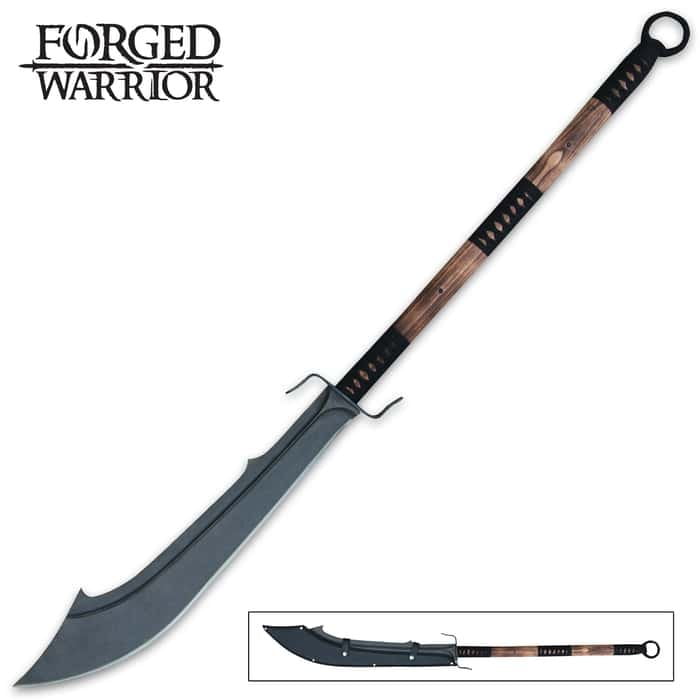Embark on an enthralling journey through the annals of ancient Chinese history as we unveil the hidden tales enshrined within their exceptional weaponry in [Unearthing the Secrets of Unusual Ancient Chinese Weapons: A Journey Through History]. Prepare to be captivated by the ingenuity and craftsmanship of these extraordinary artifacts, as we delve into the profound symbolism and strategic significance they held in shaping the destiny of ancient China.
Key Takeaways:
The Chu-Ko-Nu was a rapid-fire crossbow invented during the Han dynasty in China.
The Huo Long Chu Shui, meaning “Fire Dragon Out of Water,” was an early form of a rocket used in China in the 10th century AD.
The Claw of Archimedes was a siege weapon used to lift enemy ships and capsize them.
Archimedes’ Death Ray is a legendary weapon said to have used sunlight to set enemy ships on fire.
The Steam Cannon was an early form of a cannon that used steam as a propellant and was invented in China in the 11th century AD.
The Roman Scissor was a siege weapon with a large, spring-loaded blade used to cut through enemy fortifications.
Greek Fire was an incendiary weapon used by the Byzantine Empire from the 7th to 12th centuries AD, and its exact composition remains unknown.
Unusual Ancient Chinese Weapons: Blending Tradition and Innovation

Introduction:
In the annals of history, ancient China stands as a testament to ingenuity and resilience. From architectural marvels to military prowess, the Chinese have woven a tapestry of innovation that continues to inspire and intrigue. Among their many achievements, unusual ancient Chinese weapons hold a unique place, reflecting a blend of tradition, martial prowess, and strategic thinking
A Legacy of Innovation:
Ancient Chinese weapons are renowned for their distinctive designs, often embodying a harmony of form and function. The chu-ko-nu, a repeating crossbow capable of firing multiple bolts in rapid succession, showcased the Chinese predilection for mechanical ingenuity. Its intricate mechanism allowed for a devastating rate of fire, giving its users a significant tactical advantage.
Another example of Chinese innovation is the huo long chu shui, an early form of a rocket. Propelled by gunpowder, this weapon could travel great distances, raining fire upon enemy positions. Its invention marked a pivotal moment in warfare, foreshadowing the advent of modern rocketry.
Beyond the Battlefield:
While many ancient Chinese weapons were designed for warfare, others served ceremonial or symbolic purposes. The guan dao, a long-handled blade with a crescent-shaped blade, was often carried by imperial guards and symbolized authority and power. Its intricate carvings and tassel adornments reflected the prestige associated with its bearers.
At the heart of ancient Chinese weaponry lies a deep understanding of metallurgy and craftsmanship. Bladesmiths possessed a mastery of forging techniques, creating weapons with exceptional sharpness and durability. The jian, a double-edged straight sword, epitomized this craftsmanship. Its sleek design and razor-sharp edge made it a formidable weapon in close combat.
Cultural Significance:
Unusual ancient Chinese weapons are not merely relics of a bygone era; they embody the cultural ethos of resilience, innovation, and martial prowess that has shaped Chinese history. These weapons reflect the ingenuity of the Chinese people, their ability to adapt to changing circumstances, and their unwavering pursuit of excellence. They stand as reminders of the rich heritage that continues to inspire and influence modern Chinese society.
Conclusion:
The world of unusual ancient Chinese weapons is a captivating journey through history, innovation, and cultural significance. From the rapid-fire of the chu-ko-nu to the awe-inspiring power of the huo long chu shui, these weapons offer a glimpse into the ingenuity and craftsmanship of ancient China. They serve as a testament to the enduring legacy of a civilization that has repeatedly demonstrated its ability to blend tradition with innovation, leaving an indelible mark on the annals of history.
Want to learn about the tools used by the resourceful people of ancient Egypt? Click on tools in ancient egypt to know more.
Curious about the daily life of a craftsman in ancient Egypt? Their role in society and the skills they possessed? Find out by clicking what did craftsmen do in ancient egypt.
Wonder what craftsmen in ancient Egypt made for a living? What were their specialties? Click what do craftsmen do in ancient egypt to find out.
Did you know that ancient Egypt had a capital city? Want to know its name and its significance? Then click on what is the capital of ancient egypt to unveil the answer.
Evolution of Ancient Chinese Weaponry

We embark on a journey through time to explore the captivating realm of Ancient Chinese Weaponry, a testament to human ingenuity, fierce determination, and the ever-changing dynamics of warfare. Ancient Chinese weapons were not mere tools of destruction; they were emblems of power, symbols of status, and often held deep cultural significance. From the humble spear to the awe-inspiring repeating crossbow, each weapon tells a unique story of innovation and martial prowess.
Key Takeaways:
- Ancient Chinese weapons showcased distinctive designs that intertwined form and functionality.
- Innovation was at the heart of the Chinese approach to weaponry, leading to inventions like the chu ko nu and huo long chu shui.
- Beyond the battlefield, weapons held ceremonial significance and reflected the exceptional craftsmanship of bladesmiths.
- Ancient Chinese weapons embody the attributes of resilience, innovation, and martial prowess, mirroring the qualities of the Chinese people themselves.
Unique Features and Beyond the Battlefield
The ancients wielded a vast array of weaponry with distinctive features and applications. Specialized designs like the crescent-shaped blade of the guan dao reveal their ceremonial significance, while the exceptional forging techniques of bladesmiths produced weapons of exceptional sharpness and resilience, like the double-edged jian sword.
Innovation and Cultural Significance
The Evolution of Ancient Chinese Weaponry is a testament to the Chinese people’s ingenuity, adaptability, and pursuit of excellence. Innovative weapons like the chu ko nu, which unleashed rapid-fire projectiles, and the rocket-like huo long chu shui are symbols of China’s enduring legacy of blending tradition with innovation.
Conclusion
The Evolution of Ancient Chinese Weaponry is a captivating narrative of innovation, resilience, and cultural significance. Ancient Chinese weapons stand as a testament to the enduring creativity and pursuit of martial excellence of the Chinese people. From the awe-inspiring power of the huo long chu shui to the rapid-fire precision of the chu ko nu, these weapons showcase the rich heritage that continues to inspire modern Chinese society.
Sources:
A Brief Introduction to Ancient Chinese Military Weapons
Evolution of Ancient Chinese Weaponry
Impact of Unusual Weapons on Warfare and Society
Imagine a battlefield where the clash of swords and the twang of bows give way to the menacing whir of a multi-shot crossbow or the terrifying boom of an early rocket. Ancient Chinese warfare was no stranger to such surprises. Unusual weapons, often shrouded in myth and legend, played a pivotal role in shaping the course of battles and leaving an indelible mark on society.
Key Takeaways:
Innovation and Ingenuity: Unusual weapons showcased Chinese ingenuity and innovation in weapon design and construction, reflecting a commitment to technological advancement.
Tactical Adaptation: These weapons forced armies to adapt their tactics and strategies, leading to new formations, maneuvers, and defensive techniques.
Cultural Symbolism: Unusual weapons often carried symbolic meaning, representing power, prestige, and martial prowess, contributing to the cultural identity of ancient China.
Historical Significance: The development and use of these weapons provide valuable insights into the evolution of warfare and the social and political dynamics of ancient China.
Legacy and Influence: Many unusual weapons left a lasting legacy, influencing the design and construction of weapons in subsequent dynasties and beyond.
Unusual weapons, with their unconventional designs and devastating effects, disrupted traditional warfare, forcing adversaries to rethink their strategies and tactics. The chu ko nu, a multi-shot crossbow, unleashed a barrage of arrows, overwhelming enemy formations. The huo long chu shui, an early form of a rocket, instilled fear with its thunderous roar and destructive power.
Beyond the battlefield, these weapons had a profound impact on society. The guan dao, a long-handled weapon with a crescent-shaped blade, was not just a fearsome weapon but also a symbol of authority and status. Bladesmiths, revered for their exceptional skills, crafted weapons of unparalleled sharpness and durability, transforming them into works of art.
Conclusion:
Ancient Chinese unusual weapons stand as testaments to the ingenuity, resourcefulness, and fighting spirit of a civilization that continues to inspire awe and admiration. Their legacy extends beyond the battlefield, embodying the cultural identity, technological prowess, and enduring spirit of ancient China. Understanding the Impact of Unusual Weapons on Warfare and Society provides a fascinating glimpse into a world where innovation, adaptation, and symbolism converged to shape the course of history.
Sources:
- Ancient Chinese Warfare – World History Encyclopedia
- Swords in Ancient Chinese Warfare – World History Encyclopedia
Historical Discoveries and Ongoing Research
The annals of history are replete with awe-inspiring tales of ancient civilizations and their remarkable achievements. Among these, the Historical Discoveries and Ongoing Research into ancient Chinese weapons stand as testaments to human ingenuity, martial prowess, and the enduring spirit of innovation.
Key Takeaways:
- Ancient Chinese weapons are a testament to the remarkable ingenuity and creativity of ancient Chinese artisans and warriors.
- The study of these weapons provides valuable insights into the military strategies, technological advancements, and cultural values of ancient China.
- Ongoing research continues to shed light on the intricate details, construction methods, and combat applications of these fascinating weapons.
Unveiling the Secrets of Ancient Forging Techniques
The ancient Chinese possessed exceptional metallurgical skills, forging weapons of exceptional sharpness, durability, and aesthetic beauty. Archaeological discoveries have revealed intricate forging techniques, such as pattern welding, carburization, and quenching, which imbued blades with remarkable strength and resilience. Ongoing research aims to decipher these ancient techniques, unlocking the secrets of their exceptional craftsmanship.
Innovation in Design and Function
Ancient Chinese weapons showcased a remarkable blend of form and function. From the rapid-fire chu ko nu crossbow to the awe-inspiring power of the huo long chu shui rocket, these weapons exemplified Chinese ingenuity and adaptability. Researchers continue to explore the mechanical principles and engineering marvels behind these weapons, gaining insights into the minds of ancient innovators.
Cultural Significance and Symbolism
Beyond their martial applications, ancient Chinese weapons were imbued with deep cultural significance and symbolism. They represented power, status, and the martial virtues of loyalty, courage, and honor. Ongoing studies delve into the cultural context and symbolism associated with these weapons, shedding light on the values and beliefs of ancient Chinese society.
Preserving a Legacy of Martial Excellence
The study and preservation of ancient Chinese weapons play a vital role in safeguarding a legacy of martial excellence. These weapons embody the spirit of resilience, innovation, and the pursuit of excellence that continues to inspire modern-day martial artists and enthusiasts. Ongoing research and documentation efforts strive to ensure that these weapons and their stories are passed down to future generations.
Sources:
FAQ
Q1: What are some unique and unusual ancient Chinese weapons?
A1: Ancient Chinese weaponry boasts several unique and unusual designs, such as the Chu-Ko-Nu, a rapid-fire crossbow capable of firing multiple shots in quick succession, and the Huo Long Chu Shui, an early form of rocket used in the 10th century AD.
Q2: How did the Claw of Archimedes and Archimedes’ Death Ray demonstrate ancient Greek ingenuity?
A2: The Claw of Archimedes, a crane-like device with a grappling hook, and Archimedes’ Death Ray, a legendary weapon using mirrors to focus sunlight on enemy ships, showcase the innovative and creative thinking of ancient Greek engineers.
Q3: How did the Steam Cannon, Roman Scissor, and Greek Fire contribute to warfare.
A3: The Steam Cannon, an early form of cannon using steam as a propellant, the Roman Scissor, a siege weapon with a large, spring-loaded blade, and Greek Fire, an incendiary weapon used by the Byzantine Empire, represent advancements in military technology and weaponry during their respective periods.
Q4: Which ancient Chinese weapon was particularly effective in widening wounds and causing severe damage?
A4: The Snake Spear, a variant of the spear with a spearhead that weaves like a snake, was designed to widen thrust wounds and inflict more damage, making it a formidable weapon in ancient Chinese cavalry combat.
Q5: What types of weapons were commonly used by ancient Chinese soldiers?
A5: Ancient Chinese soldiers commonly wielded a variety of weapons, including the bow, crossbow, sword, broad knife, spear, speargun, cudgel, battleaxe, battle spade, halberd, lance, and whip, each weapon serving a specific purpose and playing a vital role in ancient Chinese warfare.
- Star Ring Trends: Etsy vs Amazon - March 28, 2025
- Boost Pollinator Habitats: Baby Blue Eyes Sustainable Farming Guide - March 28, 2025
- Protect Big Black Bears: Effective Conservation Strategies - March 28, 2025
















